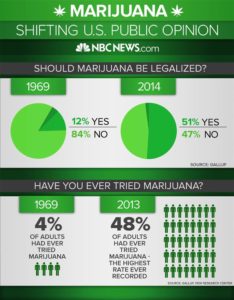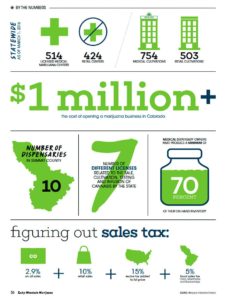Let’s look at statistics of Marijuana:
Marijuana Statistics:
- According to the United Nations estimate, 141 million people around the world use marijuana. This represents about 2.5 percent of the world population.
- A survey conducted in 2005 by the National Survey on Drug Use and Health (NSDUH) estimated 97.5 million Americans aged 12 or older tried marijuana at least once in their lifetimes, representing 40.1% of the U.S. population in that age group.
- The number of past year marijuana users in 2005 was approximately 25.4 million (10.4% of the population aged 12 or older) and the number of past month marijuana users was 14.6 million (6.0%).
- There have been over 7,000 published scientific and medical studies documenting the damage that marijuana poses. Not one study has shown marijuana to be safe.
- Another area of marijuana statistics is drug abuse violations and arrests. There were a total of 1,846,351 state and local arrests for drug abuse violations in the United States during 2005. Of the drug arrests, 4.9% were for marijuana sale/manufacturing and 37.7% were for marijuana possession.
- In fiscal year 2003, the Drug Enforcement Administration (DEA) made 5,679 arrests related to cannabis, accounting for 20.9% of all DEA arrests during the year. This is an increase from fiscal year 2002, when 5,576 cannabis-related arrests were made by the DEA, accounting for 18.5% of all DEA arrests.
- Reaction time for motor skills, such as driving, is reduced by 41% after smoking 1 joint and is reduced 63% after smoking 2 joints.
- A typical joint contains between 0.5 and 1.0 gram of cannabis plant matter, which varies in THC content between 5 and 150 milligrams.
- In 1995, 165,000 people entering drug treatment programs reported marijuana as their primary drug of addiction, showing they need help to stop using the drug.
- Among juveniles from 12 to 17 the average age of first marijuana usage is 14 years old.
- Marijuana contains 421 chemical components, 60 of which are the feature of only this substance.
- Since 1990, nearly 5.9 million Americans have been arrested on marijuana charges, a greater number than the entire populations of Alaska, Delaware, the District of Columbia, Montana, North Dakota, South Dakota, Vermont and Wyoming combined.
- In 2000, state and local law enforcement arrested 734,498 people for marijuana violations. 646,042 Americans (88 %) — were for simple possession. The remaining 12% (88,456 Americans) were for “sale/manufacture”. This is an increase of 800 percent since 1980, and is the highest ever recorded by the FBI.
- The total number of marijuana arrests far exceeds the total number of arrests for all violent crimes combined, including murder, manslaughter, forcible rape, robbery and aggravated assault.
- 75% of drug-related criminal charges are connected to marijuana.
- ******Is this worth bringing marijuans LEGAL???? NO******
Marijuana also affects brain development, and when it is used heavily by young people, its effects on thinking and memory may last a long time or even be permanent. A recent study of marijuana users who began using in adolescence revealed substantially reduced connectivity among brain areas responsible for learning and memory. And a large long-term study in New Zealand showed that people who began smoking marijuana heavily in their teens lost an average of 8 points in IQ between age 13 and age 38. Importantly, the lost cognitive abilities were not fully restored in those who quit smoking marijuana as adults. Those who started smoking marijuana in adulthood did not show significant IQ declines. Great so I can use this in retirement BUT looking at this topic as a whole it would not be best for the CHILDREN and GRANDCHILDREN in AMERICA! So honestly I am not for marijuana legally by thinking of ALL not just myself.
Marijuana use may have a wide range of effects, particularly on cardiopulmonary and mental health.
Marijuana smoke is an irritant to the lungs, and frequent marijuana smokers can have many of the same respiratory problems experienced by tobacco smokers, such as daily cough and phlegm production, more frequent acute chest illness, and a heightened risk of lung infections. One study found that people who smoke marijuana frequently but do not smoke tobacco have more health problems and miss more days of work than those who don’t smoke marijuana, mainly because of respiratory illnesses. It is not yet known whether marijuana smoking contributes to risk for lung cancer.
Many have called for the legalization of marijuana to treat conditions including pain and nausea caused by HIV/AIDS, cancer, and other conditions, but clinical evidence has not shown that the therapeutic benefits of the marijuana plant outweigh its health risks. To be considered a legitimate medicine by the FDA, a substance must have well-defined and measurable ingredients that are consistent from one unit (such as a pill or injection) to the next. As the marijuana plant contains hundreds of chemical compounds that may have different effects and that vary from plant to plant, and because the plant is typically ingested via smoking, its use as a medicine is difficult to evaluate.
However, THC-based drugs to treat pain and nausea are already FDA approved and prescribed, and scientists continue to investigate the medicinal properties of other chemicals found in the cannabis plant—such as cannabidiol, a non-psychoactive cannabinoid compound that is being studied for its effects at treating pain, pediatric epilepsy, and other disorders. For more information, see DrugFacts – Is Marijuana Medicine?
The marijuana plant contains several chemicals that may prove useful for treating a range of illnesses or symptoms, leading many people to argue that it should be made legally available for medical purposes. In fact, a growing number of states (20 as of March 2014) have legalized marijuana’s use for certain medical conditions.
The term “medical marijuana” is generally used to refer to the whole unprocessed marijuana plant or its crude extracts, which are not recognized or approved as medicine by the U.S. Food and Drug Administration (FDA). But scientific study of the active chemicals in marijuana, called cannabinoids, has led to the development of two FDA-approved medications already, and is leading to the development of new pharmaceuticals that harness the therapeutic benefits of cannabinoids while minimizing or eliminating the harmful side effects (including the “high”) produced by eating or smoking marijuana leaves. Check out more on National Institute on Drug Abuse.
This is even what “Simple Cannabis” blog states about marijuana, not saying it is safe. It states the following:
There are several rules and regulations surrounding Marijuana and as per American regulatory authorities, marijuana is classified as a Schedule 1 drug along side LSD and Heroin. Further, it is defined as being potently addictive and does not have medical usage (which can be contradicted by many other studies pertaining to marijuana research that can prove this drug has medicinal properties).
Any researcher who wishes to study marijuana, must obtain it through the NIDA (National Institute on Drug Abuse) and this particular crop has quite a few researchers willing to study this drug in numerous forms and finding out varied statistics out of it regarding its usage and consumption comparing the data from today to last several years since the time this drug was introduced as a form of drug. Since this drug generates millions of dollar business for several growers across the world, someone is arrested for marijuana offence in every 36 seconds and almost 89 percent of these offences are not a part of selling or manufacturing and might just be for possession of this drug.
While there might be several effects and harmful considerations of taking marijuana as listed in several of the websites and online journals; however it is best to stay aware and informed about such consumables prior to taking them and hence for the record there are multiple publications and books that have been written about the ill effects of Marijuana and can be accessed in the form of e-books online and even available in libraries that talk about marijuana facts and statistics. Such literary sources also talk about how marijuana affects the body internally and sensory perceptions as it has a strong addictive potential that results in strong symptoms and effects like irritability and sleeplessness along with loss of memory and slow unresponsive and nervous system that makes learning procedures a hard thing to do just about any kind of activity. It is necessary to have all the requisite information on marijuana before attempting on its consumption.
What do we as a society support the most the health of our people especially young ones future or our moment of getting high and feeling good? My answer is the health of Americans. If this drug was researched enough where it was approved by all involved on drugs it would not become legal unless it is for a MEDICAL CONDITION.

